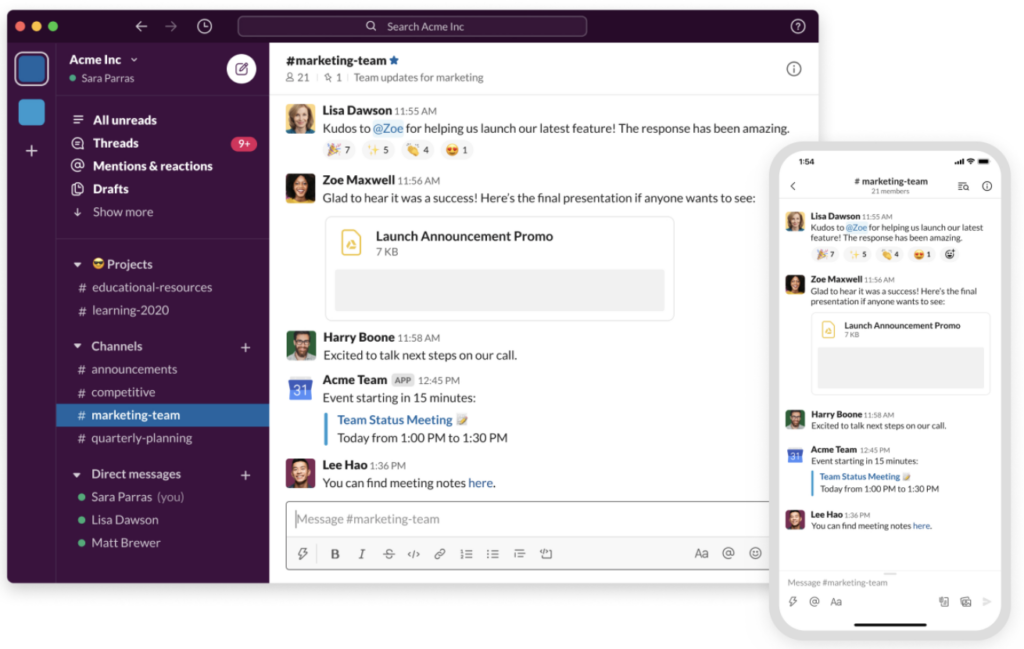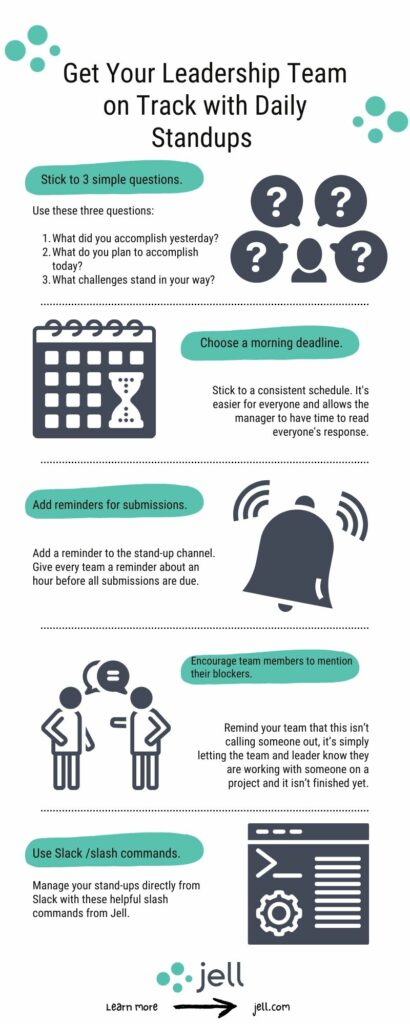
Leadership team development is hard. When I first started leading the team at Formstack, there was no question as to where we’d all be working: In the office. Every weekday. All day.
Then, one week we decided to crack the door of our completely office-based environment and peer into the hallways of remote work. If someone on my team had told me then that all our executives would work remotely by 2015, I would have been absolutely shocked.
Three years later, our executive team of five now spans as many states. We collaborate daily from remote offices in Charlotte, Dallas, Indianapolis, Oklahoma City and San Francisco.
It wouldn’t have been possible without virtual daily standups. Not the kind that require web cams and conference lines, but rather brief check-ins to collaborate on goals and share struggles—without interrupting workflows or adding another meeting to the calendar. And not just individually with our own departments but together as a team of leaders as well.
Every morning, before the email and social media pings start rolling in, I check in with my fellow directors for a smart, simple standup. Each one is quick, comprehensive, informative…and worth the few minutes it takes to complete.
So what are some features that define a good leadership team?
Write OKRs, share progress, monitor success.
14-day free trial. No credit card required.
Related Articles
How to Adapt Your Leadership Style to Different Employee Personalities
The One on One Meeting: What Every Manager Should Know
How to Use Stretch Goals with OKRs
Features That Define a Good Leadership Team
#1 Communication
Good leadership teams communicate openly. They share their thoughts with one another, their opinions, and their ideas with members of their team. Communication helps keep track of progress and helps teams work together efficiently on tasks.
Not only that but research shows that effective lateral group communication leads to an improvement in overall company performance. Employees graded as highest in work productivity also receive the most effective communication from their superiors.
Employees who receive upward communication feel empowered. Information flows upward in an organization and usually in the form of feedback. If managers listen to this feedback, this leads to an increase in employee job satisfaction. Conversely, employees are happy the other way around too–if there is strong downward communication or information flowing down from superiors or managers right to the direct reports.
#2 Shared goals
Effective leadership teams set goals together based on objectives and key results rather than work output. OKRs are bidirectional meaning they are set by the company and every individual group within the organization builds on these with their own measurable goals. Goals provide a clear direction for the company.
If you’re not sure how to set goals, Jell can help. We have our own free OKR eBook and an article with our free OKR templates. Share short-term or long-term goals and view the results in real time. Why have goals if they’re not integrated in your daily workflow? Whether you prefer quarterly or annual goals, Jell allows you to share progress at any point.
#3 Mutual accountability
Setting goals is important but why set goals if your team isn’t meeting them? Effective leadership teams hold every member of the team accountable. Teams accept responsibility as individuals and as a team. Members of the team don’t blame one another for team mistakes and failures. Effective teams celebrate their successes together and recognize the individual contributions for each member.
#4 Clearly defined roles and responsibilities
When roles and responsibilities are clearly defined, there’s no confusion as to who’s supposed to do what on the team. Team members look beyond their own individual positions and learn to understand, respect, and value everyone’s individual contributions. Every team member recognizes that the success of the team is a function of the shared contributions of everyone.
#5 Trust
Team members who are unable to trust each other on the team or who don’t believe in the process aren’t successful. Effective teams solve problems together. Trust provides a sense of safety and when your team members feel safe, they feel comfortable to open up, take risks, and expose vulnerabilities. Lack of trust leads to a lack of innovation, collaboration, creative thinking, and decreases in productivity.
Trust is essential for knowledge sharing within the team. A study published in the “Journal of Knowledge Management” found that trust was a key element in a team’s knowledge acquisition. In other words, when team members trust each other, they’re more likely to communicate openly, feel safe, share knowledge, and succeed.
Why bother with daily standups for leadership teams?
The reality is that everyone (and I mean everyone) gets stuck once in a while. Every employee needs to process ideas and challenges out loud at some point—CEOs and directors included.
Consider this common cycle:
Your team launches an exciting new project, moving with momentum to quickly accomplish tasks and achieve progress.
And then you hit it: The big roadblock. That one, tiny piece of code holding up traffic and threatening to shut down the whole darn product. Or a legal issue confounding your plans. Or perhaps an individual who won’t complete the last small-but-critical task required for success. So, what do you do? Keep reading.
Leadership Team Development: How to Get Them Back on Track

Detail a communication plan for every employee
When you’re working in an office setting, communicating with other employees is easy. But things get tricky when teams work remotely. And now with more teams working remotely than ever before in history, it’s imperative that you develop a detailed communication plan for every employee.
Make directions on how every employee can get a hold of one another. Are you going to use Slack? Google Meet? Email only?
Once you set the mode of communication, you’re ready to set the types of meetings and the frequency of each meeting. Are you going to have daily standup meetings? Sprint reviews? Weekly team meetings? One-on-one meetings?
Come up with a detailed meeting plan and ensure every employee in the company is involved with their team’s specific meeting schedule. If you don’t have a plan, it won’t happen.
Set Goals and Track Progress with Standup Meetings
At Jell, we use OKRs to set our goals. These are Objectives and Key Results, a framework pioneered by Google in its early days. OKRs assist teams with tools to track progress, align strategies, and encourage collaboration.
OKRs are set at frequent intervals–typically monthly or quarterly. As we mentioned before, OKRs are bidirectional. They don’t trickle down to the bottom like other goal setting strategies. All goals are set and every group in the company builds on them with their own goals. OKRs are transparent so all departments and individuals know their roles and know how their role contributes to the success of the goals.
Unsure of how to write OKRs? No need to fear. There’s a guide for that.
After goal setting, hold your team accountable to them by using Slack standup meetings. Every day, ask your team those three simple questions:
- What did you work on yesterday?
- What are you working on today?
- Do you have any blockers getting in your way?
Either hold your meetings over Zoom or use an application like Jell to check in through Slack.

Set your goals as a team, track your progress, and check in every day with our Slack integration.
When you have a venue where you can bring those challenges to light on a daily basis, it’s much e asier to identify solutions. Daily leadership standups provide the peer coaching you need to break through barriers when you’re stuck.
asier to identify solutions. Daily leadership standups provide the peer coaching you need to break through barriers when you’re stuck.
If you’ve ever waited days for a report from your staff only to find another team had created a similar document months ago, you know exactly what I’m talking about. Have you ever strived for a new goal that’s already been reached? Or created a resource for one team without realizing it was more desperately needed by another?
Far too often we find ourselves duplicating efforts and frustrations because we don’t keep the right lines of communication open. Daily standups take care of that.
Take care of your employees’ well-being
Are you communicating regularly with your team? Do you know how each member is doing at work or otherwise? Before you can take care of your employees’ well-being, you need to know what you’re dealing with. The only way to know is to ask.
That’s the glory of a one-on-one meeting. One-on-ones are an integral part of effective leadership. We use one-on-one meetings on a weekly basis which is why we decided to add them in our reporting feature.
Check in with each member of your team and ask them a few questions:
- What are their long-term career plans?
- How happy are they at work?
- Do they have any frustrations I can help with?
- Are they performing well?
- Are there areas for potential improvement I can coach them on?
If you can’t answer these questions for every employee working under you, then this is the perfect opportunity to ask them in your weekly or bi-weekly check-ins.
The more you understand what employees are going through, the easier it is to decide what’s best for your team.
If an employee on your team is struggling, how can you help them? Do they need a day off? Motivation? Encouragement? Find out each employee’s needs and try to meet their needs.
Don’t micromanage your team

Which managerial style refers to you?
Are you a hands-off manager that prefers to take a step back from your employees and give them autonomy?
Or are you the manager hawking over them like a helicopter, parenting them every step of the way?
If you’re more like the latter, then chances are you’re a micromanager (sorry to break it to you).
Study after study shows that workplace autonomy increases an employee’s sense of job satisfaction, motivation, creativity, and well-being. Many managers often find their employees more productive when they abandon their helicopter monitoring ways.
Autonomy in the workplace:
- Gives employees needed feelings of ownership and loyalty
- Improves productivity
- Reduces labor costs
- Promotes job satisfaction
- Improves workplace adaptability
- And more.
How can you promote autonomy in your workplace?
Trust your workers to do the job. You don’t need to spoon feed them their work. Trust them and give them the chance to prove themselves and trust them to recover from their mistakes.
Also, allow your employees to make mistakes. No one is perfect, and that’s a good thing. Mistakes are how we learn and how we grow. As a manager, encourage your employees to try new things and make mistakes. Instead of reacting angrily, talk through the problem and figure out what happened and how it can be prevented in the future. Turn negative situations into a learning experience for your team.
When you give your employees a safe space to make mistakes, you’re also fostering an environment of respect, an important ingredient to a strong leadership team.
Build respect
There are a host of benefits to respecting employees in the workplace. Respect reduces stress, increases productivity, and increases employee satisfaction. And respect is not freely given, it’s earned. To build respect,
- Always communicate politely using an affable and warm tone.
- Share your thoughts and encourage your employees to do the same.
- When a team member talks, don’t interrupt them, or tease them for anything they say.
- Don’t scold your team members in front of others.
- Don’t criticize any idea or suggestion of your team members.
- Always praise your employees for quality work and encourage your employees to work harder
These are only a few ways to build respect in the workplace. Over time, you’ll develop a strong team that communicates effectively and treats one another fairly.
Still not sure if these tips are for you? At least consider this:
What is the most important objective for your organization in the coming quarter? Hitting a revenue target? Opening a new line of business? Improving profit margins?
Now imagine what could happen if every member of your leadership team starts the day by answering one key question:
“What are you doing to achieve [BIG, IMPORTANT GOAL]?”
This question removes distractions so you can refocus on the big picture.
As a manager, it’s your job to set up a detailed communication plan, track the goals and goal progress of your team in a fair way. Don’t micromanage your team and always foster an environment of safety and respect.
What about you? How does your leadership team get back on track? We’d love to hear your tips on Twitter.
